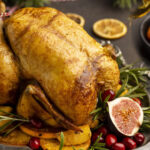Ideas for diabetic-friendly Christmas food
Diabetes is one of the most prevalent chronic conditions in older people. New figures released by the International Diabetes Federation show that over 4 million adults in South Africa are living with diabetes. That’s 1 in 9 of us … and the incidence of diabetes is on the rise. Blame our modern way of life. Less exercise and easy access to fast food mean that a growing number of South Africans are overweight. And obesity is one of the key factors leading to the development of type 2 diabetes.
Depending on the severity of the condition, it may be controlled with diet and exercise alone. But in other cases, medication is needed to help regulate insulin production.
What foods should diabetics avoid?
Obviously sugar is top of the list of foods to avoid. Sweets, chocolates, biscuits and cakes are out, except in very small quantities. But sugar has crept into so many other products where you wouldn’t expect to find it. Peanut butter, for example. Breakfast cereals like muesli, which seems like a healthy option. Instant cappuccino and flavoured coffee sachets, and fruit juices, even those that claim to be 100% blended fruit juices.
Other refined carbohydrates like bread, rice and pasta also cause blood sugar spikes and weight gain – as do fatty and processed foods.
Help – I need to cater for a diabetic guest this Christmas
If you’re hosting a festive dinner this year, and one of the guests has diabetes, deciding what to serve can be daunting. Traditional Christmas fare – honey glazed ham, Christmas pudding, mince pies and pavlova – are definitely not diabetic-friendly foods.
Best for diabetics are lean meats, with plenty of vegetables and fresh fruit instead of sugar laden desserts smothered in cream. But there’s no need to forego all the treats. With a bit of thought, you can create a diabetic-friendly menu that offers options to make guests with diabetes feel welcome and safe, and give your other guests a healthier meal too. For example, if you normally serve vegetables smothered in cheese sauce, simply plan to serve the sauce separately.
Diabetic-friendly main course
You can still serve turkey and ham, if it doesn’t feel like Christmas without the traditional fare. Most store bought turkeys are self-basting so there’s no need to add oil to the roasting tin, or cover the bird with strips of bacon to prevent it drying out. Use only a small quantity of olive oil if necessary. And allow guests to serve themselves, so your diabetic guest can choose leaner portions without skin or crackling.
Plan to serve plenty of vegetables with the meal. There’s no need for them to be a boring afterthought. Try this visually appealing Mediterraean roasted broccoli recipe.
Diabetic-friendly dessert
Fresh fruit is a healthy dessert option for diabetics. Although most fruits taste sweet, the sweetness comes from fructose, which does not affect blood sugar levels in the same way as sucrose. Instead of pavlova, serve festive berries with low fat ice-cream or unsweetened frozen yoghurt on the side. Or try this clever home-made ice-cream hack.
Don’t keep them waiting
People with diabetes need to eat regular meals to prevent sudden spikes in their blood-glucose levels. If you are worried that you might not be able to dish up the meal on time, offer healthy snacks for them to nibble on.
Instead of bowls of roasted nuts and crisps, or rich, creamy dips served with salty crackers, opt for a dip made from fat free Greek yoghurt or cottage cheese, served with raw carrot matchsticks, celery sticks, cucumber slices, mange tout, and baby corn.
Stock up on mineral water, sugar-free fruit juices and diet soda to offer diabetic guests. People with diabetes have to limit their alcohol intake, especially if they take insulin or tablets to control the condition. Mixing medication with alcohol can produce dangerously low blood glucose levels, and increase the risk of hypoglycemia.
If your guest enjoys a drink, gin, vodka and whiskey, served with sugar free tonic or soda water have zero carbs. Light (alcohol reduced) beer and wine are also thoughtful options to have on hand.
Diabetic-friendly recipes
Although these recipes are suitable for diabetics, they are tasty and healthy enough to be enjoyed by anybody! Especially during the festive season, when many people over-indulge. Go ahead and give them a try.
Mediterranean roasted broccoli and tomatoes
Pre-heat the oven to 180 degrees. Toss broccoli florets and whole baby rosa tomatoes in a tablespoon of olive oil, crushed garlic and salt to taste. Spread in an even layer on a baking sheet and bake for 15-20 mins until the broccoli begins to brown.
In a large bowl, combine half a teaspoon of lemon zest with a tablespoon of lemon juice, some sliced black olives, and a teaspoon each of dried oreganum and rinsed capers. Add the roasted vegetables and stir to coat. Serve warm.
Non-dairy ‘ice-cream’
All you need is a bunch of ripe bananas and a high power blender or food processor. Simply blend the bananas to a creamy consistency and freeze. If the banana sticks to the blade or sides of the blender, add a small amount of almond or coconut milk (3-4 tablespoons) to help things along. Flavour with a teaspoon of unsweetened cocoa powder, vanilla essence or cinnamon if desired.
Frozen yoghurt berry bites.
Another super easy desert option using just two ingredients – yoghurt and berries. Make sure you choose unsweetened yoghurt and simply mix in raspberries, blackberries, blueberries or chopped strawberries. You can even use kiwi fruit or peaches for a different option. Pour into a silicone ice tray and freeze for about 3 hours. Optional extra – sprinkle coconut on top before freezing.
Diabetic-friendly Christmas Cake
Try this light, sugar free fruit cake version. You will need:
- 1 medium orange
- 250g fresh prunes, quartered
- 500g dried mixed fruit
- 2 tsp ground mixed spice
- 4 large eggs
- 225g softened butter
- 2 tbsp milk
- 300g plain flour
- 1tsp baking powder
Method
Finely grate the orange zest and squeeze the juice. Pour the juice into a measuring jug and top up with cold water to 200ml. Pour into a large saucepan and add the zest, prunes, mixed dried fruit and spice. Simmer gently for 3-4 minutes until the liquid is almost all absorbed, stirring occasionally. Remove from the heat and leave to cool for 30 minutes.
Preheat the oven to 160°C. Grease and line the base and sides of a 20cm round deep cake tin with nonstick baking paper.
Whisk the eggs together in a large bowl then stir in the butter, milk, flour and baking powder. Beat with a wooden spoon until smooth. Stir in the soaked fruit until thoroughly mixed. Spoon into the prepared tin and level the surface with the back of a spoon. Cover the tin loosely with a piece of aluminum foil.
Bake in the centre of the oven for 1 hour. Remove the foil and bake for a further 30 minutes or until the cake is pale golden brown and a skewer inserted into the centre comes out clean. Remove the cake from the oven and cool in the tin for 30 minutes. Carefully turn out, peel off the lining paper and leave to cool completely on a wire rack.
Decorate with flaked almonds or mint leaves.






 Robin Hood Foundation spreads love across Tafta Homes
Robin Hood Foundation spreads love across Tafta Homes 12 Days of Giving – spread joy to older people this Christmas
12 Days of Giving – spread joy to older people this Christmas Tafta resident pens powerful tribute to heritage and hope in new book
Tafta resident pens powerful tribute to heritage and hope in new book Introducing TEAL – our upgraded national Elder Abuse Helpline
Introducing TEAL – our upgraded national Elder Abuse Helpline Beat the year-end blues – 6 tips for staying positive during ‘silly season’
Beat the year-end blues – 6 tips for staying positive during ‘silly season’ Wisdom on ageing – the most exquisite chapter
Wisdom on ageing – the most exquisite chapter Thriving through 2025 – a toast to life
Thriving through 2025 – a toast to life ‘Human Forever’ inspires Durban audience
‘Human Forever’ inspires Durban audience Celebrating 100 years of life with Mrs Rosemary De Waal
Celebrating 100 years of life with Mrs Rosemary De Waal Open Days at Tafta – explore safe and supportive accommodation options.
Open Days at Tafta – explore safe and supportive accommodation options.